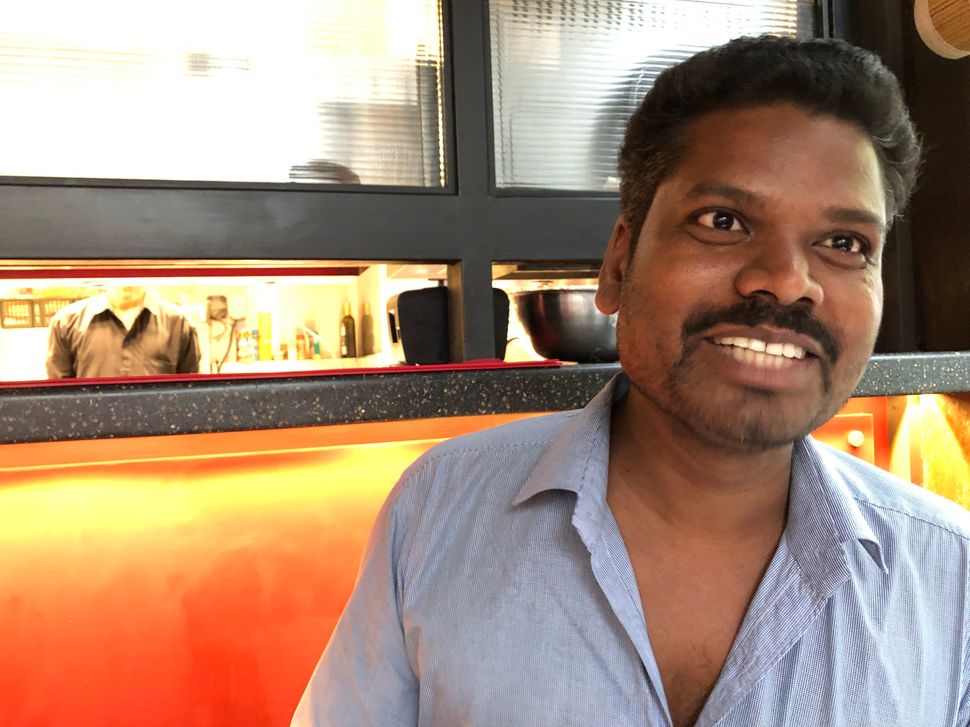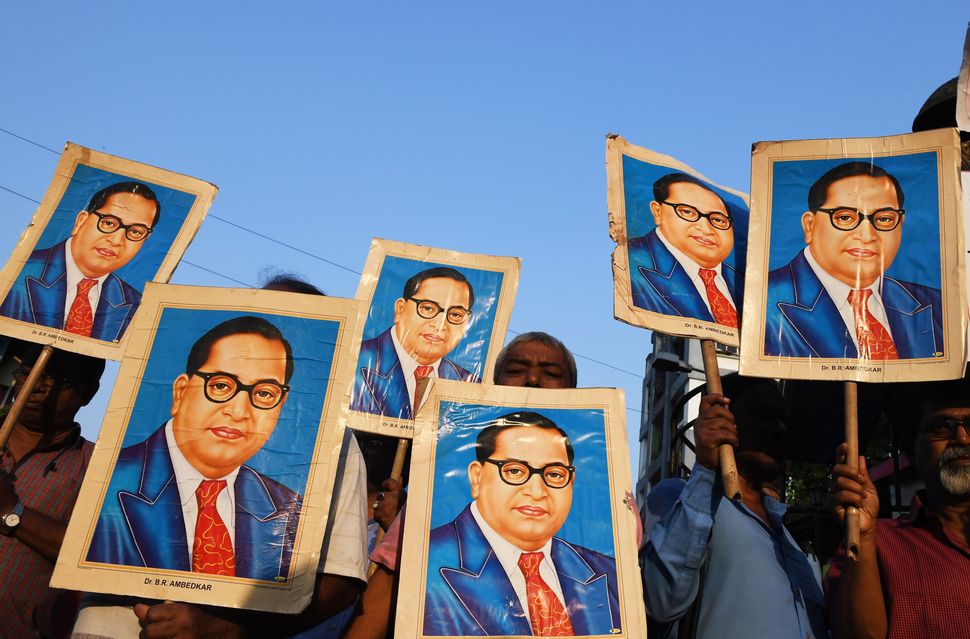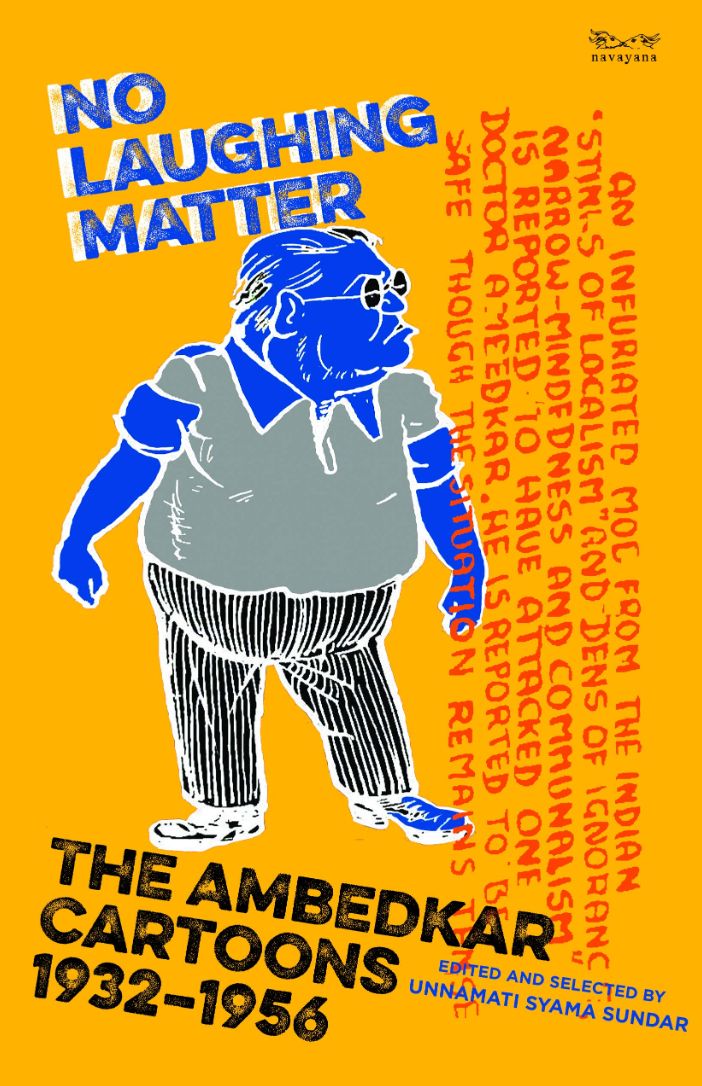
No Laughing Matter: The Ambedkar Cartoons 1932-1956 by Unnamati Syama Sundar is a damning expose of the casteism of the English press during the Independence movement and early days of nation-building.
The book, published by Navayana, archives cartoons published in English media on Dr. B.R. Ambedkar as he does some of his most important political work—as a labour member of the Executive Council, fighting for representation of Dalits in the new Indian government, his work on the Constitution, and the Hindu Code Bill which sought to increase the rights of women and was bitterly opposed by conservative Hindus. The book shows how the so-called “legends” of Indian cartooning, including Shankar, Earan, Oommen and Vasu, used casteist and sexist ideas and visual symbols to lampoon the mass leader, even as he strove to lay an egalitarian foundation for the nation. Many would argue it is the job of a cartoonist to make fun of everyone. But, the book points out, it is not that simple.
What is funny about drawing Ambedkar as short and childish when he puts forward his critique of fellow leaders and their policies? Or as a woman who has sex with a number of men, when he creates alliances to further his radical, egalitarian politics? Or, as an orthodox Brahmin, the very ideology he fought against his whole life?
For the latest news and more, follow HuffPost India on Twitter, Facebook, and subscribe to our newsletter.
No Laughing Matter pulls back the curtain on the power structure that underlies the history of cartooning in India, and the medium’s use as a political weapon. It also forces us to reflect on what these cartoons, just some decades old, tell us about our society. The idea that it’s “just” a joke is negated by the fact that they were published at a time when reports of grievous violence against dalits were commonplace in newspapers—indeed, Ambedkar himself carefully documented these in his writings like The Untouchables. The easy coexistence of power, violence and humour finds echoes in social and political life even today, where the pendulum swings between the infuriating “Can’t you take a joke” to cases of sexual harassment and assault by popular comedians that came to light in the #MeToo movement. For creators and readers of cartoons, comics or even memes, it is important to reflect on the questions this book raises.
In a recent conversation with this writer, Sundar discussed these nuances, the political and social landscape of the cartoons archived in his book, and his own work. The research scholar and cartoonist began archiving cartoons of Ambedkar in 2012.
Edited excerpts:
The idea for this book was born when a controversy broke in 2012 over the inclusion in an NCERT textbook of a cartoon depicting Nehru (a Brahmin) whipping Ambedkar, who was seated on a snail labelled ‘Constitution’. What was your take on it?
Many people still argue that there’s no problem with the cartoon because they think it’s just a cartoon. In the rest of the world, it’s not like that—look at how controversial the Charlie Hebdo cartoons on Prophet Mohammed are. So, let’s debate the issue at least. Let’s look at the rest of the cartoons, archive them, and then come to a conclusion. Was there any bias? What is the pulse of the cartoonist? How are other leaders depicted by the same cartoonist, as compared to Ambedkar?
As far as other leaders are concerned, these were out-and-out Congress papers. They wouldn’t depict Congress leaders poorly. For example, despite being a very popular cartoonist at the time, Shankar resigned from Hindustan Times because owner Devdas Gandhi wanted him to withdraw a cartoon on his father-in-law C. Rajagopalachari. Jinnah, on the other hand, was badly lampooned. But then Jinnah had a paper—Dawn—to counter this and there was a kind of cartoon rivalry going on at the time of Partition. The cartoonist who drew the NCERT cartoon—Shankar—was very close to Nehru.
See, every image can be read and interpreted in multiple ways. The sensitive aspects should be explained with context. For example, when you see Nehru whipping—it is ambiguous whether he is whipping Ambedkar or a snail. When you’re talking about the delay in the making of the Constitution in a textbook, you cannot simply put a cartoon in the chapter and say this is how it was. The delay in the process happened due to heated debates, but the image connotes that it is solely Ambedkar who is responsible. I would say instead of publishing an old cartoon of 1949—because the cartoonist may have drawn a cartoon to those conditions—it would have been better if they had commissioned an artist to draw new cartoons which are not hurtful.
What do you think was the intent behind the cartoons archived in your book?
The intent was to distort the work that Amebdkar was doing, and create a negative image of him. It came from a casteist grudge and was also a reaction to his anti-Gandhi and anti-Congress stance.
Was there any opposition to these cartoons at that time?
I didn’t get this cartoon, otherwise I would have used it. Shankar, the cartoonist was invited to Lady Irwin College for their convocation as the chief guest. When the graduates came on stage to receive their degree, he happened to see some of them wearing lipstick. The very next day in Hindustan Times, his cartoon said ‘Thinking of opening a lipstick service station at Connaught Place’. Rajkumari Amrit Kaur, who was an activist, complained that the cartoon was done in bad taste and action must be taken. She complained to (MK) Gandhi, who called up Shankar to meet. When Shankar showed him the cartoon, Gandhi didn’t think there was anything wrong in it. He excused it, and started laughing at it. This event is documented in Shankar’s biography.
When we were about to release the book, we came across another instance which occurred in the 1950s, when Hindu Code Bill debates were at their peak. There was a cartoonist in a Hindi newspaper who had drawn Ambedkar dragging a dead carcass. Ambedkar was very angry and wanted to file a case against them but the newspaper appealed to him to withdraw the case. Otherwise, however, he knew that cartoonists were lampooning him but he was seriously into drafting the Draft Constitution, and the Hindu Code Bill. So, from his point of view they were probably rubbish.
Did the cartoons impact the way Ambedkar and his ideas were seen?
When you look at the chronology of Ambedkar’s life, there are no cartoons on the most serious issues that he worked on. Speaking as a cartoonist, if you choose the correct topic, then the cartoon is already 50% successful. When I look at the newspaper articles at the time, some of the issues these cartoonists chose to highlight makes me think they missed the point. For example, among his scholarly works, the most notable is Annihilation of Caste. When it was published in 1936, it was debated very seriously between Gandhi and Ambedkar. Despite this, why don’t we see any cartoons on Annihilation of Caste in the English press? The cartoonists at that time couldn’t catch on to what Ambedkar was. I would say he was far ahead of his time, and these cartoonists had no clue. Another example is of when the Hindu Code Bill was being discussed. Today, we would expect that the cartoonists would draw in favour of Ambedkar and women’s rights, but many cartoonists at the time took a negative view of Hindu Code Bill. They said he was spoiling Hindu culture and women’s freedom. This tells us what kind of cartoonists we had in those days. With regard to circulation, the cartoons were limited to English press. A few were republished or copied in the vernacular press but didn’t reach the same mass base as—for example—Chandamama or Chacha Chaudhary today.
You comment in the book on how all these cartoonists seem to be using variations of the same ideas and symbols, or a common visual register. Why do you think this was the case?
Indian cartoonists cannot escape from mythology. If they want to create an association, they tend to go back to mythology and use that. Unfortunately, readers relate to that very quickly and that is why they pick up these themes. Although these cartoonists took the format from Western cartoonists, they injected the casteism and misogyny of mythologies into these forms. For example, the cartoons that depict Ambedkar as Draupadi with five husbands. Shankar liked cartoonist David Low’s presentation very much, so he adopted his presentation but the themes are the same. If we could disconnect mythology from our cartoons and comics, that would be best. Unfortunately, almost all cartoonists continue to rely on mythology even today.

The politics of who is making the joke and who the joke is aimed at is becoming an important cultural debate. Could you comment on where you think the line should be vis-à-vis the right to free speech?
We have multiple identities coming up in society – new trends have emerged, new movements have come. Back then, they used to depict male politicians wearing saris. They were misogynists. Nowadays, you can’t simply draw any cartoon on a dalit woman or a Muslim woman or a tribal woman or the third gender. You will have reactions from different sections of society.
Where do we draw the line? Cartoonists have to get educated. You should know the basics. If you want to make political cartoons, you should have at least a basic understanding of history and Indian politics—you should know the draft Constitution; the politics of Gandhi, Ambedkar, Subhas Chandra Bose; the position of scheduled castes, Muslims and tribals in India. Cartoonists have a responsibility to be connected to society, and their work must reflect it as well. Even contemporary cartoonists do not do this. There are also not enough female cartoonists today.
In this context, what do you think about the political role of lampooning?
The definition of lampooning has changed. It should be meaningful. Lampooning is what we cartoonists do if a politician is lying or distorting a historical fact, then we decide to correct that through a cartoon. I don’t think that means showing them as a woman and meaning it as an insult, as they did with Ambedkar.
Do you see this kind of lampooning even today?
I think that the impact of cartooning is going down because digital and graphic media like memes have come in. People are crazy about memes, not cartoons. You can do anything with memes—you can morph anything, it’s a limitless medium. This technology has increased the level of misogyny and hatred. If you see funny pages, the sexist content gets a high response from people. Or if there are any memes on Ambedkar, they are about reservation and merit because that is the only thing that comes to their mind when they see him. When I see Ambedkar, I think of the Constitution.
Would you say memes have replaced the space of casteism and misogyny these cartoons used to occupy?
Yes, memes get a fast response and you find a lot of anti-reservation themes, misogyny and false patriotism there.
Are there any visual symbols or materials that have countered the representation of Ambedkar that we see in the cartoons archived in your book?
Statues of Ambedkar have been used as a kind of symbol of self-respect. The best thing that happened in hamlets or ghettoes was placing statues of Ambedkar. It’s beyond just a statue, especially when he’s holding the Constitution. It’s a counter to Gandhi, where Gandhi is holding a Gita. The Constitution could be seen as a counter to the Gita. Gita means Manu—so it is a counter to Manu and Manu dharma. The Constitution is modern, and is about an egalitarian society. So, indeed, these statues have created a kind of belongingness, our own God, a symbol of self-respect, a symbol of Constitution.
Where do you get inspiration from as a cartoonist?
I find the cartoonist David Low’s work inspiring. He conveys his message with subtlety. His World War cartoons are his best work. There are also the colonial-era cartoons from Andhra which address social issues, the orthodoxy of the Brahmins and irrational thought. For example, there was one cartoon of a Brahmin driving a car and hitting another Brahmin. His wife says “See that Brahmin’s leg is broken” and the other Brahmin says, “Look, it’s his karma. Let’s leave it”. So, they were exposing that kind of irrationality. In the 1920s-1930s there was a party called Justice Party which was a non-Brahmin party. It emerged in response to Brahmins’ advancement in Congress. This Justice Party used to counter Brahmins’ oligarchy and orthodoxy by raising the issue of untouchability, to expose how irrational they are. Following their work, there were several digests with cartoons (like the one described earlier) on social issues. One such digest was called Samadarshini (meaning Equal Vision). In south India, we didn’t have Punch but had our own cartoon digests in vernacular languages. They were radical. Even the Punch series was very progressive.

What questions do you try to raise through your work?
See, the way we think is shaped by our education, the kind of books we read, the kind of leaders we like, and the kind of ideology that we follow. I think after reading Ambedkar, everything, even my drawing, has changed. When I draw cartoons, I always keep in my mind the anti-caste elements, issues related to women, and minorities. These are generally ignored or distorted by the mainstream media. We have to study the issues, and regularly follow them. We have to look at what is really happening on the ground—for example, Bhim Army. When we see the name, we immediately think of sticks or beating someone up but it was started to increase primary education. They started some 300 schools in UP. But the press won’t show this, or say this.
I think as cartoonists, we also have to look at the issue from all sides before making something. How would those who don’t agree with you see the cartoon? For example, if you draw a cartoon on reservation, you have to look at the opposing view and put your points forward accordingly. You should also look at what’s happening within—I have drawn cartoons about the Dalit movement also, for example, about how women are treated at seminars, or their representation on the panels. I think we should criticise our own movements because that is when we will have a democratic space. Long ago, I even drew a cartoon on myself! Sitting in a room, drawing cartoons and not going to the polling booth to vote (Laughs). It is a way to have a democratic space.
What’s next for you?
Currently I am working on a book on Babasaheb’s visit to coastal Andhra in 1944. He was there for three days. This book will explore the purpose of Babasaheb’s visit, his speeches and rare photographs. I am also working on a second book, Ambedkar, B.G. Horniman & the Bombay Sentinel, which was about the Bombay Sentinel newspaper. Almost all newspapers were negative about Babasaheb, but Bombay Sentinel was positive. My question is, why?
Vidyun Sabhaney is a writer, illustrator and editor of graphic narratives. Her recent works include First Hand 1 and 2.